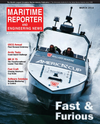
Page 23: of Maritime Reporter Magazine (March 2014)
U.S. Coast Guard Annual
Read this page in Pdf, Flash or Html5 edition of March 2014 Maritime Reporter Magazine
www.marinelink.com 23 recommended intervals. With the newer technology emerging, such as these on- line performance monitoring systems, traditional methods of maintenance are being replaced by predictive maintenance programs, thereby reducing budgets tre- mendously. According to the Electri- cal Power Research institute scheduled maintenance programs cost about $24 per horsepower. Another option typically employed, but not recommended, correc- tive/reactive maintenance, which comes in averaging $17 per horsepower. This, however, doesn’t put a price tag on the other factors involved in this scenario, like downtime costs, and stress. When a predictive maintenance program is in place, such as condition monitoring by online systems, you can reduce your costs to around $9 per horsepower, which is a huge savings. Another reason why engineers love these systems is because they’ve been designed to reduce mainte- nance schedules by about 20,000 hours.
With reduced hours, minimal downtime, and non-invasive monitoring, budgets re- main just as healthy as equipment. “Class has also recognized the inherent value in condition based monitoring and has issued guidelines for implementing such programs. Another benefi t: with the switch from diesel to dual fuel engines, enhanced monitoring will provide further information on the mechanical health of the engines and the condition of the control systems for the controlling of cylinder pressures,” explained Ed Kelle- her Manager of International Sales, Win- drock. “auto-balancing” of cylinder fi r- ing pressures with the patented Windrock
AutoBalance system on larger natural gas engines has been successfully used to control emissions, reduce fuel costs and reduce the overall mechanical degrada- tion of mechanical components due to imbalances.” “The push towards online monitoring is a progressive and exciting movement in the maritime industry,” commented Mer- hige. “Besides the economic benefi ts to maintenance budgets, this is also a cost effective way to be more “green,” by in- creasing, and maintaining mechanical ef- fi ciency and optimization. This is becom- ing increasingly important to companies that own and operate these vessels.”
What online monitoring boils down to is working smarter, rather than harder.
And, as this technology is quickly and continuously evolving, “smarter” is only going to get easier and more economical for operators.
The Authors
Rich Merhige has over 31 years of condition monitoring experience. He founded/is President of AME, which is recognized as an external spe- cialist for condition monitoring by ABS. [email protected]
Teresa Drugatz joined AME in 2010 as Offi ce/
Marketing Manager. She holds a bachelor of sci- ence in communication from the University of
Miami. [email protected] TERESA DRUGATZ
TM
MR #3 (18-25).indd 23 3/4/2014 2:35:03 PM

 22
22

 24
24
